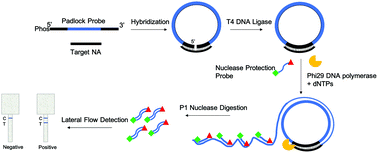Padlock probe-based rolling circle amplification lateral flow assay for point-of-need nucleic acid detection
Abstract
Sensitive, reliable and cost-effective detection of pathogens has wide ranging applications in clinical diagnostics and therapeutics, water and food safety, environmental monitoring, biosafety and epidemiology. Nucleic acid amplification tests (NAATs) such as PCR and isothermal amplification methods provide excellent analytical performance and significantly faster turnaround times than conventional culture-based methods. However, the inherent cost and complexity of NAATs limit their application in resource-limited settings and the developing world. To help address this urgent need, we have developed a sensitive method for nucleic acid analysis based on padlock probe rolling circle amplification (PLRCA), nuclease protection (NP) and lateral flow detection (LFA), referred to as PLAN-LFA, that can be used in resource-limited settings. The assay involves solution-phase hybridization of a padlock probe to target, sequence-specific ligation of the probe to form a circular template that undergoes isothermal rolling circle amplification in the presence of a polymerase and a labeled probe DNA. The RCA product is a long, linear concatenated single-stranded DNA that contains binding sites for the labeled probe. The sample is then exposed to a nuclease which selectively cleaves single-stranded DNA, the double-stranded labeled probe is protected from nuclease digestion and detected in a lateral flow immunoassay format to provide a visual, colorimetric readout of results. We have developed specific assays targeting beta-lactamase resistance gene for monitoring of antimicrobial resistance and Severe Acute Respiratory Syndrome-Coronavirus-2 (SARS-CoV-2, the novel coronavirus discovered in 2019) using the PLAN-LFA platform. The assay provides a limit of detection of 1.1 pM target DNA (or 1.3 × 106 copies per reaction). We also demonstrate the versatility and robustness of the method by performing analysis on DNA and RNA targets, and perform analysis in complex sample matrices like saliva, plant tissue extract and bacterial culture without any sample pretreatment steps.



 Please wait while we load your content...
Please wait while we load your content...